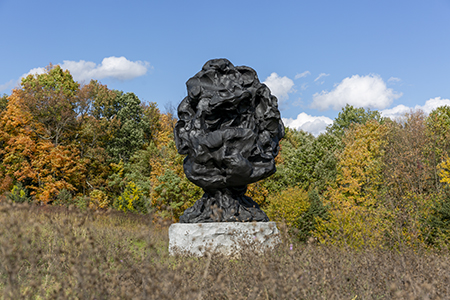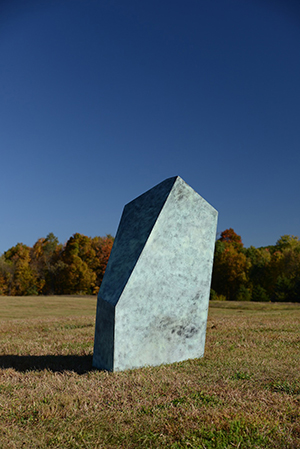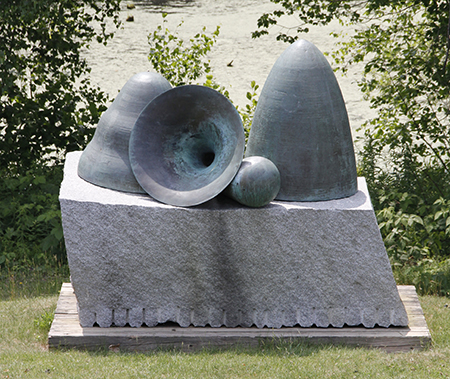Art Omi: Showcasing the True Nature of Sculpture
There are moments of a day when Will Ryman’s bronze sculpture Sisyphus plays with the pattern of the tree line at Art Omi Sculpture & Architecture Park in New York’s Hudson Valley.
“Sometimes the 16-foot tall bronze blends in, sometimes it stands out in contrast with the forest about 40 feet away,” says Nicole Hayes, sculpture park curator.
 Will Ryman, Sysiphus. Courtesy Art Omi.
Will Ryman, Sysiphus. Courtesy Art Omi. Photo by Bryan Zimmerman.
Forged at the famous Polich Tallix foundry in Rock Tavern, NY, Sisyphus, with its satin-y black patina, sometimes looks as if the hands of God came out of the sky and rendered a giant portrait into the space, Hayes remarks.
“It’s really beautiful,” she says. “From some angles it looks like a blob of clay and if you look at it from certain angles a human face emerges.”
The piece was brought into the sculpture park last year and will be on view until 2022.
Created by sculptor Will Ryman, the artist remarks that the point of the Sisyphus myth is that true happiness is in the pursuit of something. “Instead of meaninglessness, there’s almost too much meaning in life—choices, struggles and questions. Along the way of his daily task, Sisyphus experiences all of those and becomes his actions,” he says.
Ryman is an American artist who is internationally recognized for his bold figurative sculptures that take their inspiration from the urban landscape and flora of epic proportions.
Art Omi describes Ryman as playfully imbuing his figurative symbols with an acute sense of theatricality and emotion that harkens back to his early career as a playwright. Ryman explores the ways in which poignant narratives can be expressed using a range of found objects and repurposed materials.
 Catherine Lee, Constant Resolve.
Catherine Lee, Constant Resolve. Photo courtesy of Art Omi.
Ryman’s work is one of three bronze pieces on display at the 120-acre sculpture park in the town of Ghent that is part of the nonprofit founded in 1992. In addition to the sculpture park, Art Omi offers education and residency programs for international artists, writers, dancers, musicians and architects.
Since its founding, Art Omi has hosted more than 2,000 artists from more than 100 countries. Art Omi presents the works of contemporary artists like Ryman and architects, and offers a range of large-scale works in nature, plus a 1,500 square foot gallery.
The Sculpture & Architecture Park currently offers more than 60 works by artists and architects on view, with pieces added or exchanged each year. Many of the pieces on view are created in bronze or mixed media. Art Omi welcomes the public to its events and grounds free of charge, and is open daily.
Hayes said Art Omi’s collection of sculptures changes in response to contemporary society and selection for display is driven by an interest in challenging notions of what art in the landscape should be. People see nature differently with sculpture around it, she says.
The works are more about the artist in the world at this moment, Hayes said. Fewer artists work exclusively in one medium, instead choosing the medium to suit their expression.
Ryman, for instance, also has a piece in the park made of cast resin and steel called Pac Lab, which mimics a video game.
Another significant bronze piece is artist Catherine Lee’s Constant Resolve, part of a series Constants which she exhibited in 2014.
“This piece is really interesting,” Hayes says. “It’s not cast. It’s actually fabricated from sheets giving it a faceted, glacier-like form.”
Hayes said the piece looks as if it was pushed up from the earth. The piece sits tucked into a forest with indigenous flowers such as bloodroot and trout lily.
“It kind of has this sense of being in a magical forest when all these things start growing around it,” she says.
The green patina has been painted on in an active painterly way, Hayes describes.
 Tony Cragg, Untitled.
Tony Cragg, Untitled. Photo courtesy Art Omi.
Lee has been creating large scale bronze works since the late 80s. In time these works have evolved from wall mounted unions of two or more parts, to rigid self standing Sentinels, then the Hebrides and Sibyl series, where Lee began to truly explore three dimensional space along with her continual exploration of surface and abstract shape.
"Constants is a reference to what we can count on, something that might show us the way, something we can trust to be there and rely upon," writes Catherine Lee on the Art Omi artist statement. "I wanted them to have enough weight to anchor the field but not to overpower it. The fact that each Constant changes radically, visually, as you circle around is a purposeful challenge to their constancy — until one realizes that the relationship of each facade to each other facade is really just proof of the proverbial 'whole that is greater than the parts', a recurring theme in my work for many years.”
Although Art Omi is not a collecting institution, an untitled bronze piece by British sculptor Tony Cragg was recently donated.
Cragg is one of Britain's foremost sculptors, who constantly pushes the boundaries between people and the material world. He works with stone, wood, found objects, aluminum, cast bronze and iron.
The forms of his work range from repetitive stacks to witty floor arrangements of objects that he began making in the 80s. He was originally trained as a scientist and worked as a lab technician, which is reflected in his vigorous approach to material use.
In Cragg’s piece, four cast-bronze forms sit atop a block of granite. The bell-like organic forms the rough hewn granite.
“These forms are ambiguous and can be referenced to naturally occurring shapes, vessels, or man-made objects,” says Hayes. “The precariousness of this leaning marble base with these heavy, bell-shaped forms play with the water element of the sculpture park, a former farm pond that is now a wetland.”
Art Omi has several talks and tours planned throughout the summer, including a July Picnic in the Park series, Open Studios, Art Camps for children and more.
Resources:
Also in this Issue:
- Art Omi: Showcasing the True Nature of Sculpture
- Randolph Rose Collection: Creating Bronze Legacies that Stand the Test of Time
- The Whimsical Wildlife Bronzes of Pokey Park
- Rare 1900s Gilded Native American Weathervane Auctioned
- Rare 19th-Century Bronze Vase Designed by Thomas Hope Discovered in Oklahoma Collection
